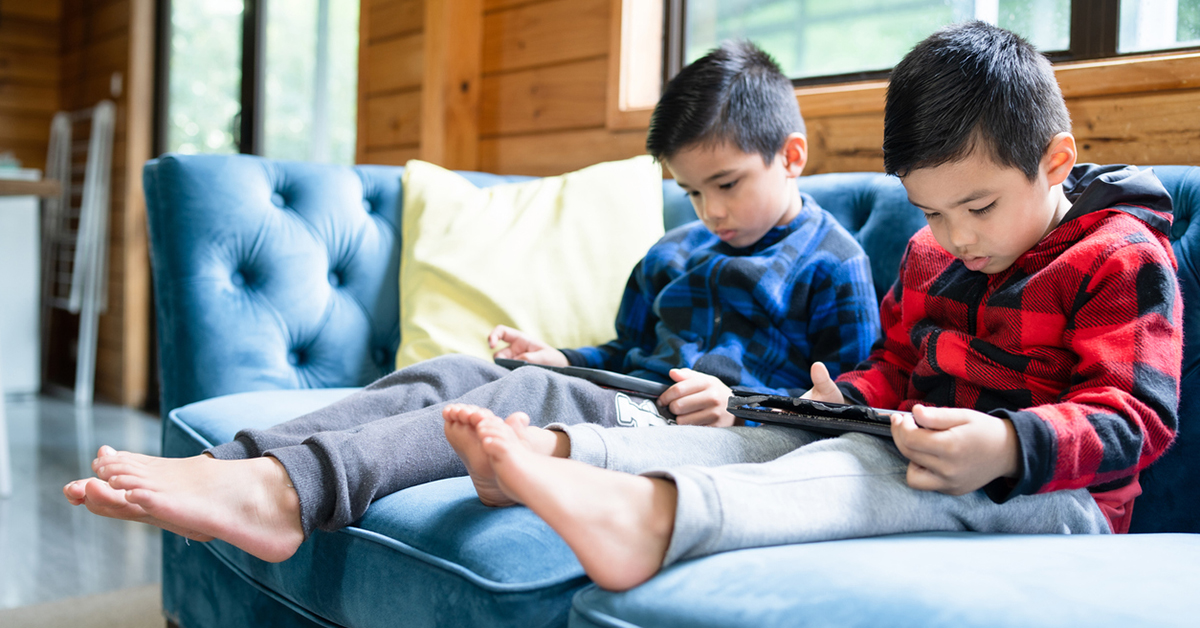If you’ve ever plopped a child in front of a television tuned to the Cartoon Network, or handed over your iPad to get a moment of peace and quiet, you know the almost magical powers of screens. Screens can work wonders to distract or entertain kids. But how much screen time is too much?
The recommendations
The American Academy of Pediatrics calls for no screen time before 18 months. It also recommends introducing screen time gradually to children between 18 to 24 months and no more than one hour per day of high-quality programming for children from 2–5 years. Educational apps or television programming that encourages interaction, like Sesame Street, Super WHY or Little Einsteins are considered high-quality. Older kids, those ages 5–17, should get no more than two hours of screen time a day, not including virtual learning or homework.
The reality
The reality is that most kids are coming in way above the recommendations. In fact, 87 percent of children had screen time exceeding the recommendations. The latest statistics show that most American children spend about three hours a day watching television. Added together, all types of screen time (television, working on a computer, looking at social media, or playing video games), can total 5–7 hours a day.
Risks of excessive screen time
Surfing the internet, scrolling Facebook or Instagram, watching YouTube videos or binging shows can add up screen time hours in no time. Too much screen time can put kids at risk for problems, such as:
- Sleep issues
Screen time can affect how quickly kids and teens fall asleep and how long they sleep. Screen time in the hour before bed can act as a stimulant. In addition, the blue light from electronics may suppress melatonin levels and delay sleepiness. For many, the temptation to stay up late playing games or chatting with friends is strong, further disrupting their sleep schedule and leading to fatigue. - Behavioral and mental health problems
If you’ve noticed a child becoming moody, irritable, easily frustrated or defiant, take a look at their time in front of screens each day. One study published by the AAP suggests greater television and computer use, just over two hours a day, were directly related to higher psychological difficulties. In addition, nearly 20% of children experience mental health challenges, and for most, screen time can exacerbate mental health issues. - Obesity
It may be obvious, but time spent in front of a screen is time spent not being physically active. The more screen time kids have, the greater their risk of becoming overweight. Having a TV or other electronics in a child’s bedroom increases this risk as well. Children can also develop an appetite for junk food promoted in ads, as well as overeat while watching on electronics. - Less time for play
Excessive screen time leaves less time for active, creative play. This type of play is critical for sensory development, exploring imagination, concentration and attention, and building confidence.
Benefits of screen time
While the downside of screen time is clear, the upside should not be overlooked. Internet Matters points out some of the benefits.
- Online games and activities can enhance teamwork and creativity.
- The internet gives children access to a wealth of information to help build their knowledge.
- Interacting with computers improves both visual intelligence and hand-eye coordination.
- Technology can take away physical barriers to social connections – which is important for children who find it hard to make friends or have special interests or special needs.
- Children in households with computers perform better academically than peers who do not have ready access to computers.
Finding the right balance
Still, finding boundaries for kids and technology is one of today’s great challenges for parents. The Academy of Nutrition and Dietetics offers these pointers to help your child or teen disconnect from their screens.
- Remove media from the bedroom. Kids with a TV in their bedroom watch about 1.5 hours more a day than kids who don’t have one in their bedroom.
- Enjoy electronic-free meals. Make it a family rule to turn off the TV while eating and ensure everybody puts away their cellphones so you can focus on each other.
- Save TV for weekends. Watch shows as a family and fast-forward through commercials. Sit down with your kids and help them select specific shows they’ll watch, giving them some control and helping them make decisions.
- Enjoy an action-packed evening. After dinner, take the dog for a walk, go for a family bike ride, or play outdoor games or active indoor games.
- Turn off Saturday morning cartoons. Take kids to the local park, recreation center or health club. Play a game of basketball, let them climb on the monkey bars, or sign them up for swimming lessons or organized team sports.
- Get up and dance. Take off the headphones, turn up the music, and have a family dance contest.
- Hang out with friends. Encourage older kids to get together with their friends and do something fun, such as walking around the mall, going sledding, or playing a pickup game of soccer. For younger kids, ask them to invite a friend over and encourage active forms of play.
- Play interactive video games. Invest in or rent video games that require kids to get up and move their arms and legs—no sitting allowed. Just Dance is a great option for all ages!
- Make screen time an active time. When kids do watch TV, make it active. Have a contest to see who can do the most push-ups or jumping jacks during a commercial break.
- Choose programming that is interactive. Popular choices include Cosmic Kids Yoga or Go Noodle.
- Create a family screen time policy. As a family, discuss ways to cut back on recreational screen time. Ask the kids to come up with reasonable limits; as parents, you should do the same. Then write up a contract, have everybody sign it, and remember to post it where it is visible.
Looking for more ideas? Since media habits are different for every household, the American Academy of Pediatrics has developed a Family Media Plan which can be customized to meet your family’s needs. Make a full plan, or just choose a few parts that matter the most to your family. Create your Family Media Plan by visiting the APA website.













